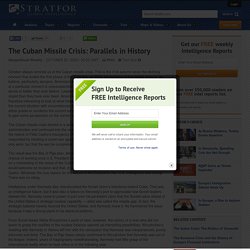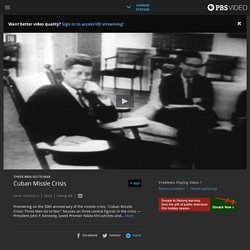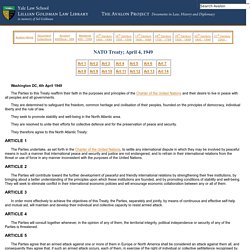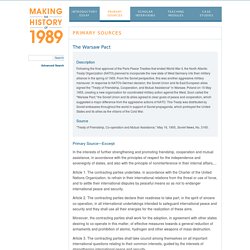

On the Brink of Nuclear War: Leadership and the Cuban Missile Crisis. Teaching with the News Objectives.

The Cuban Missile Crisis: Parallels in History. October always reminds us of the Cuban missile crisis.

This is the 41st autumn since the defining moment that ended the first phase of the Cold War. In 2003, the memory of the missile crisis is, we believe, particularly apropos. Americans in general tend to think that everything the country is facing at a particular moment is unprecedented. Americans tend to think in extremes. Everything is either worse or better than ever before. The Cuban missile crisis started in a series of intelligence blunders that began under one administration and continued into the next. Watch Three Men Go to War Online. A personalized PBS video experience is only a few clicks away.

Use one of the services below to sign-in to PBS, and you'll be able to manage videos in your Watchlist, keep track of your favorite shows, watch PBS in high definition, and much more! You've just tried to add this video to your Watchlist so you can watch it later. But first, we need you to sign-in to PBS using one of the services below.
You’ll be able to manage videos in your Watchlist, keep track of your favorite shows, watch PBS in high definition, and much more! You've just tried to select this program as one of your favorites. To get you watching PBS in high definition we need you to sign-in to PBS using one of the services below. You'll be able to manage videos in your Watchlist, keep track of your favorite shows, watch PBS in high definition, and much more! NATO Treaty; April 4, 1949. NATO Treaty; April 4, 1949 Washington DC, 4th April 1949 The Parties to this Treaty reaffirm their faith in the purposes and principles of the Charter of the United Nations and their desire to live in peace with all peoples and all governments.

They are determined to safeguard the freedom, common heritage and civilisation of their peoples, founded on the principles of democracy, individual liberty and the rule of law. They seek to promote stability and well-being in the North Atlantic area. They are resolved to unite their efforts for collective defence and for the preservation of peace and security.
They therefore agree to this North Atlantic Treaty: The Parties will contribute toward the further development of peaceful and friendly international relations by strengthening their free institutions, by bringing about a better understanding of the principles upon which these institutions are founded, and by promoting conditions of stability and well-being. The Warsaw Security Pact: May 14, 1955. The Bay of Pigs. On April 17, 1961, 1400 Cuban exiles launched what became a botched invasion at the Bay of Pigs on the south coast of Cuba.

In 1959, Fidel Castro came to power in an armed revolt that overthrew Cuban dictator Fulgencio Batista. The US government distrusted Castro and was wary of his relationship with Nikita Khrushchev, the leader of the Soviet Union. Before his inauguration, John F. Kennedy was briefed on a plan by the Central Intelligence Agency (CIA) developed during the Eisenhower administration to train Cuban exiles for an invasion of their homeland. Cold_war_europe_military_alliances_map_en.png (PNG Image, 1165 × 1200 pixels) - Scaled (83%)
Cuban Missile Crisis. A War Best Served Cold. 1946-1968: Cold War. Cuban Missile Crisis. Cuban Missile Crisis: Three Men Go To War. The Warsaw Security Pact: May 14, 1955. NATO Treaty; April 4, 1949. The Warsaw Security Pact: May 14, 1955. NATO Treaty; April 4, 1949. Making the History of 1989. Primary Source—Excerpt.

National Cold War Exhibition. 1946-1968: Cold War. 1946-1968: Cold War. The Society for Historians of American Foreign Relations. Formally titled “The Sources of Soviet Conduct,” the X-Article appeared in the July 1947 issue of Foreign Affairs magazine.

Shortly thereafter, the identity of the author, “X,” was revealed as George Frost Kennan, then the new Director of the State Department’s Policy Planning Staff. Historians consider this article the most significant public explanation of America’s emerging policy of “containment” toward the Soviet Union. Born in February 1904 in Milwaukee, Wisconsin, Kennan evidenced several characteristics during childhood that later defined his diplomatic career: keen intelligence, driving ambition, and a remote personality.
After graduating from Princeton in 1925, he decided to join the newly reshaped and expanded Foreign Service. From 1927-1933, Kennan served in a variety of European posts until late 1933, when he accepted an assignment to the American mission (later embassy) in Moscow; he remained there until he was transferred to Washington DC in 1937. M. Bibliography: